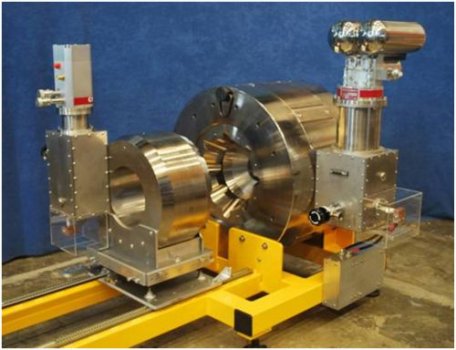One hundred years since the discovery of superconductivity, and 25 years since the first high-temperature superconductor (HTS) was discovered, HTS materials are being used in synchrotron instruments and magnets – and synchrotrons are helping to reveal the very complex physics of HTS materials.
Jeff Tallon, an HTS expert from Industrial Research Ltd in New Zealand who addressed the Australian Synchrotron User Meeting on this topic in December 2011, predicts that the impact of HTS in synchrotron science will grow markedly over the next decade.
Although the technology has been slow to mature, HTS magnets and coils are now used in commercial motors, generators, transformers, cables, defence and transport applications (see http://www.hts110.co.nz/, for example). HTS materials are often the only solution, or more economical than conventional systems. Synchrotron applications include HTS magnets built for the Hahn-Meitner Institute for x-ray diffraction at high field, the LNLS in Brazil and the TATA Institute of Fundamental Sciences for ion focussing at the Pelletron LINAC facility in Mumbai. HTS dipole magnets supplied to Brookhaven National Laboratory (retrofit) and the Taiwan Proton Source at NSRRC require 20 times less power than conventional copper-wound coils. Perhaps the most complex HTS magnet system yet delivered to a synchrotron is the 9 Tesla large-area rapid imaging analytical tool (LARIAT) for 3-D NEXAFS measurements being installed at NSLSII (see picture).
Several synchrotron x-ray absorption and diffraction techniques have contributed extensively to HTS physics. More recent studies using an x-ray technique called angle-resolved photoemission spectroscopy (ARPES) and infrared ellipsometry suggest that it may be possible to develop superconductors that operate at higher temperatures (such as 180K or -93 degrees Celsius). A key challenge would be to find a way to suppress the superconducting fluctuations that set in at about 70-100K above current critical temperatures. Now there’s a goal.
Warning: seriously technical language below!
Synchrotron science has contributed extensively to HTS physics. While EXAFS, XANES and resonant XRD have been important, the dominant contribution has been from ARPES and, more recently, infrared ellipsometry. ARPES has shown that a Fermi surface exists (at least on the overdoped side), has mapped the dispersion, the Fermi surface and the momentum dependence of energy gaps, and revealed the renormalisation of the bare dispersion that describes the crucial coupling between electrons and bosons. The thermodynamic and magnetic properties calculated from the dispersion agree closely with direct measurements of electronic enthalpy, entropy and susceptibility, across the entire phase diagram. The infrared studies expose the same energy gaps and reveal the transfer of spectral weight as these gaps open. It turns out that superconducting fluctuations set in 70 to 100K above Tc. If these fluctuations could be suppressed, much higher Tc values (180K) could be achieved. Now there’s a goal.
 Dr Jeff Tallon (photo at right) is Distinguished Scientist at Industrial Research Ltd, Lower Hutt, New Zealand. j.tallon@irl.cri.nz
Dr Jeff Tallon (photo at right) is Distinguished Scientist at Industrial Research Ltd, Lower Hutt, New Zealand. j.tallon@irl.cri.nz

Photo at left: 9 Tesla and 0.8 Tesla magnets for the LARIAT NEXAFS system at NSLSII Brookhaven National Lab. Designed and constructed by HTS-110 Ltd, New Zealand. Photo: Jeff Tallon, IRL
